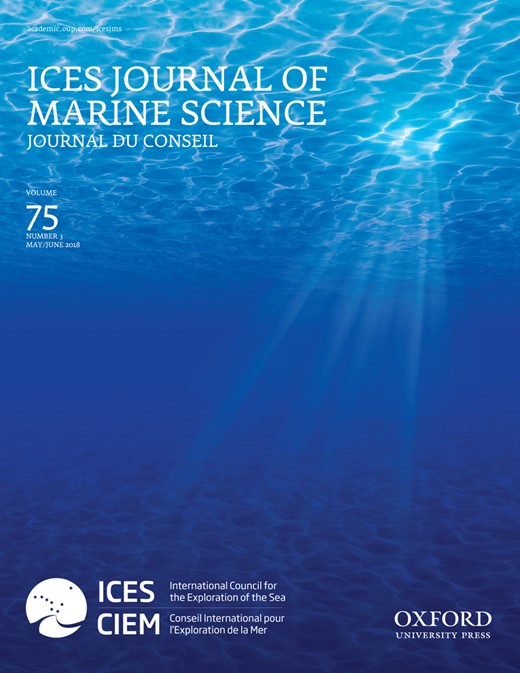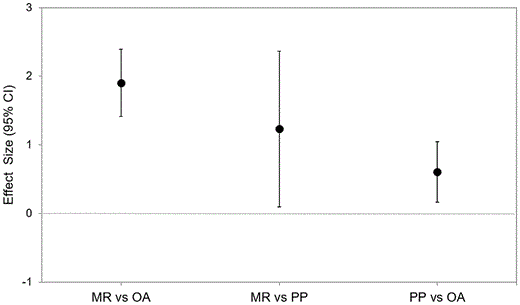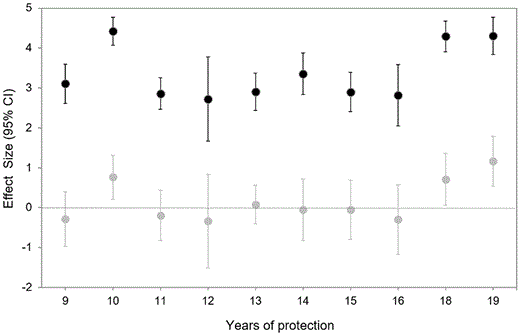-
PDF
- Split View
-
Views
-
Cite
Cite
Enric Sala, Sylvaine Giakoumi, No-take marine reserves are the most effective protected areas in the ocean, ICES Journal of Marine Science, Volume 75, Issue 3, May-June 2018, Pages 1166–1168, https://doi.org/10.1093/icesjms/fsx059
Close - Share Icon Share
Abstract
Marine protected areas (MPAs) are an essential tool for reversing the global degradation of ocean life. Hence, it is important to know which types of MPAs are more effective, and under which conditions. No-take marine reserves – the MPAs with stronger protection – are very effective in restoring and preserving biodiversity, and in enhancing ecosystem resilience. A new meta-analysis of previous studies shows that biomass of whole fish assemblages in marine reserves is, on average, 670% greater than in adjacent unprotected areas, and 343% greater than in partially-protected MPAs. Marine reserves also help restore the complexity of ecosystems through a chain of ecological effects (trophic cascades) once the abundance of large animals recovers sufficiently. Marine reserves may not be immune to the effects of climate change, but to date, reserves with complex ecosystems are more resilient than unprotected areas. Although marine reserves were conceived to protect ecosystems within their boundaries, they have also been shown to enhance local fisheries and create jobs and new incomes through ecotourism.
As of March 2017, 3.5% of the ocean was within implemented “Marine Protected Areas” (MPAs), and only 1.6% was in strongly protected (no-take) MPAs (Lubchenco and Grorud-Colvert, 2015). Despite the recent increase in large MPAs worldwide, we are still short of the United Nations target of 10% of the ocean protected by 2020. Although MPAs are a key tool for ocean conservation, there is some uncertainty regarding when and where MPAs are most effective (Woodcock et al., 2016). Here, we show that no-take MPAs are very effective in restoring and preserving the ecosystems they are designed to protect from human exploitation.
What’s a marine protected area?
There are many MPA definitions, but in summary, MPAs are areas that are intended to protect all or part of a marine ecosystem. At the most protective end of the spectrum are no-take “marine reserves” – areas where extractive activities are prohibited. The rest are “partially protected MPAs” that allow extractive activities to different degrees. Here we will distinguish between these two groups (NCEAS, 2001; Lubchenco and Grorud-Colvert, 2015) and discuss only areas whose goal is to protect and restore marine biodiversity.
How effective are MPAs?
First, we need to define why are MPAs created. As originally conceived, the main goal of MPAs is to protect and restore biodiversity within their boundaries. “Biodiversity” ranges from species richness and abundance to the structure of ecosystems (Sala and Knowlton, 2006).
The fish come back
A meta-analysis of scientific studies (Supplemental online material) shows that the biomass of the whole fish assemblage is, on average, 670% greater within marine reserves than in unprotected areas, and 343% greater than in partially-protected MPAs (Figure 1). Fish biomass in partially protected MPAs was only 183% greater than in unprotected areas, and often it was not different from unprotected areas (e.g. Aburto-Oropeza et al., 2011). In addition, fish biomass was restored in marine reserves over time after protection, but not in partially-protected MPAs or unprotected areas (Figure 2).
Comparison of ecological benefits between no-take marine reserves (MR) and partially-protected MPAs (PP). Meta-analysis of 10 studies using log-ratios of total fish biomass (see Supplemental online material). OA, Open Access (unprotected).
Recovery of fish biomass over time in adjacent marine reserve (MR; black dots) and partially protected MPA (PP; grey dots). Log-ratios of fish biomass relative to open access (unprotected) areas nearby (OA). Modified from Garcia-Rubies et al. (2013).
What about the rest of the ecosystem?
Marine reserves can cause indirect effects that restore the structure and complexity of the ecosystem as it was before overexploitation – once predator abundance recovers sufficiently. For example, in the Mediterranean and New Zealand, sea urchin predators reduce sea urchin density and consequently have shifted the ecosystem from a degraded state (sea urchin barren) to a complex, healthy state (algal forests with high biodiversity) (Shears and Babcock, 2003; Guidetti and Sala, 2007). Initial detection of effects on target species was 5 years on average, but detection of indirect effects on other taxa (e.g. sea urchins, abalone, algae) took 13 years (Babcock et al., 2010). In tropical seas, unfished reefs with very large fish biomass also tend to be associated with greater coral coverage and less coral disease than fished reefs (Sandin et al., 2008), and a microbial ecosystem with less bacteria, viruses and pathogens (Dinsdale et al., 2008). Such effects are not so apparent in places like the Caribbean, however, because most marine reserves have not achieved yet a sufficient abundance of large fishes to exert their significant ecological function.
Can MPAs protect from climate change?
MPAs may not provide resistance against warming, but they can provide resilience. In 2016, a strong El Niño event caused the most severe coral bleaching event in history, which killed 67% of the coral in the northern part of the Great Barrier Reef in Australia in just nine months (Hughes et al., 2017). However, corals in the Line Islands affected by the strong 1997–1998 El Niño recovered in fully protected reefs within a decade, whereas they did not in unprotected islands (Sandin et al., 2008). In Baja California, Mexico, a mass mortality event caused by climate-driven oxygen depletion affected pink abalone populations, but they replenished faster within marine reserves because of large body size and high egg production of the protected adults (Micheli et al., 2012).
Can MPAs help improve fisheries?
In the late 1990s, some fishers and fisheries scientists, mostly in the United States, started to criticize MPAs, arguing that they can harm fishing (Hilborn et al., 2004), and trying to place the burden of proof on conservationists (Dayton, 1998). A flurry of studies followed, focused on whether MPAs produce fish “spillover” that could help adjacent fisheries. Although MPAs were not initially conceived to help catch more fish outside their boundaries, well-enforced marine reserves can increase adjacent fishery catches, ensure the sustainability and increase the long-term profitability of local fisheries (Halpern et al., 2009; Goñi et al., 2011; Sala et al., 2013).
Some studies investigated the trade-offs between protection and displacement of fishing effort to adjacent areas, concluding that there is a risk these areas are depleted faster (Dinmore et al., 2003; Hiddink et al., 2006), and that fishers displaced by protection would suffer economic losses. However, as of March 2017, only 1.6% of the ocean is fully protected from fishing, thus the displacement and the economic loss issues are currently insignificant at the global scale. Locally, the value of marine reserves can also exceed the unprotected counterfactual and offset short-term losses for fishers (Sala et al., 2016). Also, in many places marine reserves also create other business opportunities, mostly through ecotourism, as the growing SCUBA diver population wants to travel to where they will see abundant marine life. In some cases, fishers can offset potential losses and increase their incomes almost immediately (Sala et al., 2013, 2016).
Conclusion
No-take marine reserves are by far the most effective type of MPA. They restore the biomass and structure of fish assemblages, and restore ecosystems to a more complex and resilient state. Partially protected MPAs can have some value by restricting specific activities (e.g. banning trawling to prevent habitat destruction), but in general they are not as effective. Marine reserves are no panacea for the ocean’s problems, but they provide outstanding ecological and economic benefits within and beyond their boundaries. In other words, they provide more than what they were initially designed for.
Supplementary data
Supplementary material is available at the ICESJMS online version of the manuscript.
Funding
Research for this essay was supported by National Geographic Pristine Seas, Prince Albert II of Monaco Foundation, and Total Corporate Foundation.
References





